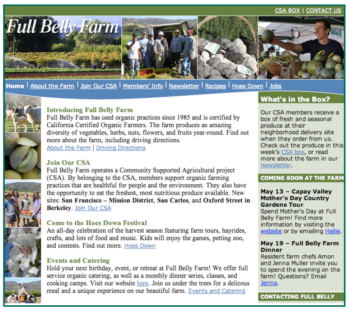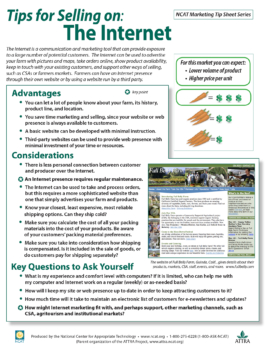Tips for Selling on the Internet
NCAT Marketing Tipsheet Series
By Marisa Alcorta, Rex Dufour and Tammy Hinman, NCAT
The Internet is a communication and marketing tool that can provide exposure to a large number of potential customers. The Internet can be used to advertise your farm with pictures and maps, take orders online, show product availability, keep in touch with your existing customers, and support other ways of selling, such as CSAs or farmers markets. Farmers can have an Internet presence through their own website or by using a website run by a third party.
For this market you can expect:
- Lower volume of product
- Higher price per unit
Advantages
- You can let a lot of people know about your farm, its history, product line, and location.
- You save time marketing and selling, since your website or web presence is always available to customers.
- A basic website can be developed with minimal instruction.
- Third-party websites can be used to provide web presence with minimal investment of your time or resources.

The website of Full Belly Farm, Guinda, CA, gives details about their products, markets, CSA, staff, events, and more.
Considerations
An Internet presence requires regular maintenance.
- There is less personal connection between customer and producer over the Internet.
- The Internet can be used to take and process orders, but this requires a more sophisticated website than one that simply advertises your farm and products.
- Know your closest, least expensive, most reliable shipping options. Can they ship cold?
- Make sure you calculate the cost of all your packing materials into the cost of your products. Be aware of your customers’ packing material preferences.
- Make sure you take into consideration how shipping is compensated. Is it included in the sale of goods, or do customers pay for shipping separately?
Key Questions to Ask Yourself
How might Internet marketing fit with, and perhaps support, other marketing channels, such as CSA, agritourism and institutional markets?
- What is my experience and comfort level with computers? If it is limited, who can help me with my computer and Internet work on a regular (weekly) or as-needed basis?
- How will I keep my site or web presence up to date in order to keep attracting customers to it?
- How much time will it take to maintain an electronic list of customers for e-newsletters and updates?
Tips for Selling on the Internet
Outline your goals for your farm’s Internet presence. This process will allow you to determine what resources (labor, expertise, software, hardware) you need to support these goals.
- Make your website easy to use and easy to find. Ask for feedback from friends and customers.
- Select a website address (“domain name”) that is short, meaningful, easy to spell, and easy to remember.
- Diversify your marketing strategies. Don’t rely on your website as your only marketing channel or tool for your business.
- Consider using Facebook and Twitter to connect with a large number of potential customers.
- Keep a blog and use other social media to keep customers interested in what is happening on your farm.
- Guide people to your site.
—Create and trade links to related websites.
—List your web address in Buy Fresh Buy Local and other farm guides.
—Use an e-newsletter that links to your website.
—Put your website and email address on all your farm’s printed material.
—Sign up with websites that point to local produce such as www.localharvest.org.
Resources
- Buy Fresh Buy Local chapters promote locally produced food. See a nearby chapter to find potential customers for your farm products and to learn more about local and Internet marketing.
- Foodzie helps small food producers and farmers across the U.S. reach new customers and connect directly to customers searching for foods and gifts. Cost of using this service is tied to product sales.
- Local Harvest is a nationwide directory of small farms, farmers markets, and other local food sources. The site helps consumers buy what they want directly from the farmers and ranchers who produce it.
- CSAware is a customizable, user-friendly Community Supported Agriculture software program. It allows your CSA members to sign up for your program online, let you know when they’ll be out of town, and order any special items you offer. As the administrator, you can see and manage all of that information, set what goes into the boxes each week, manage your drop-off site information, email some or all of your members, print out harvest lists, box labels, and member sign-in sheets, and perform other functions.
- Harvie (formerly Small Farm Central) was started by an ex-farmer who ran a CSA. The company provides, for a price, support to farmers to develop their own website as part of their marketing strategy. They offer a free trial as well as variable rates and levels of support service to help you develop and maintain your website. The site also provides member management services to CSAs and allows farmers to sell products on their website.
- How to Direct Market Farm Products on the Internet (a 50-page pdf download) is an excellent guide to developing internet marketing goals, doing research on internet consumers, setting up and marketing a website, and using the experience of a variety of farmers who use the internet to support their sales. Good resources section with links to relevant software, articles and publications.
Tips for Selling on the Internet
© 2012 National Center for Appropriate Technology—NCAT
By Marisa Alcorta, Rex Dufour and Tammy Hinman, NCAT
IP428
This publication is produced by the National Center for Appropriate Technology through the ATTRA Sustainable Agriculture program, under a cooperative agreement with USDA Rural Development. This publication was also made possible in part by funding from USDA/NIFA/OASDFR. ATTRA.NCAT.ORG.
Related Publications
- Tips for Selling at Farmers Markets
- Tips for Selling at Roadside Stands
- Tips for Selling to Aggregators/Grower Marketing Coops
- Tips for Selling to Institutional Markets
- Tips for Selling to Wholesale Buyers at Terminal Markets
- Tips for Selling to Produce Distributors
- Tips for Selling to Produce Packing Houses
- Tips for Selling with Agritourism and “Pick-Your-Own”


